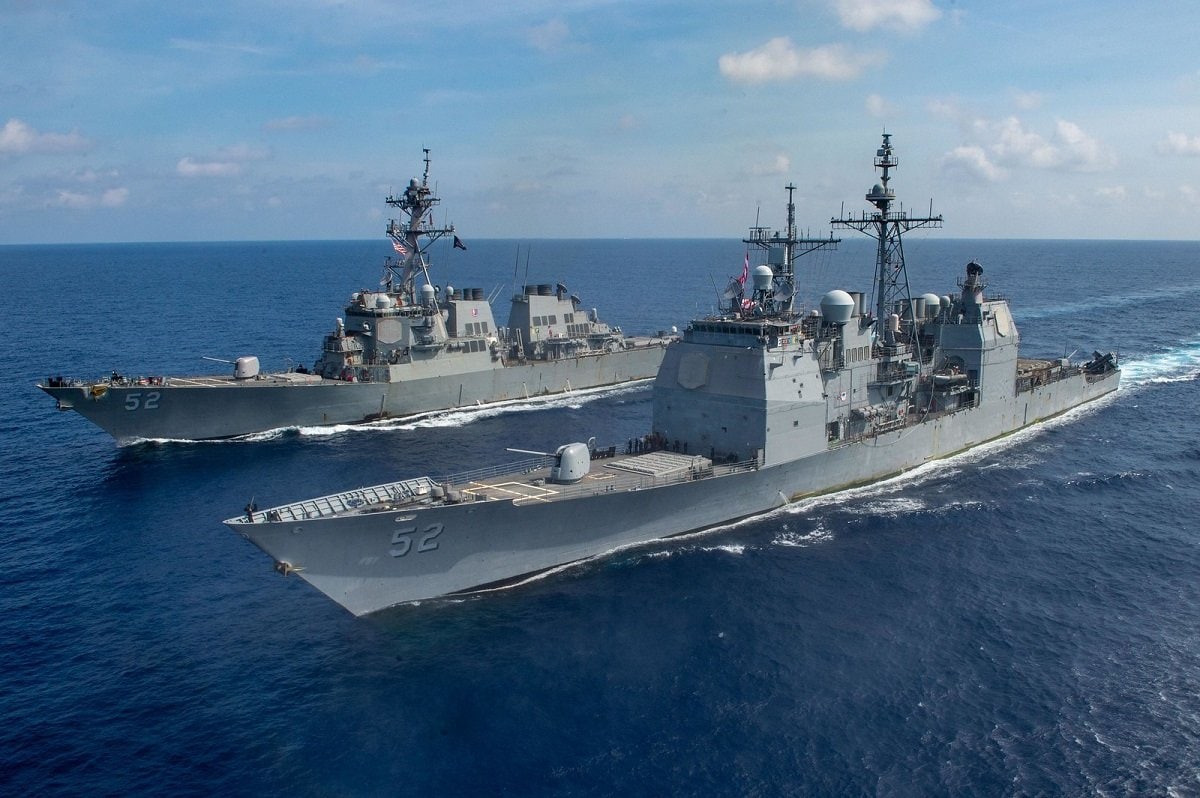Summary and Key Points: The Ticonderoga-class cruisers, introduced in the 1980s, have been vital U.S. Navy air-defense assets due to their powerful Aegis Combat System and large missile capacity (122 Vertical Launch Cells). Their proposed retirement, however, has sparked controversy.
-Critics highlight the risk of capability gaps as China expands its navy, emphasizing the cruisers’ unique air-defense specialization.
-Although Arleigh Burke-class destroyers could partially fill the void, their smaller size and multi-role responsibilities limit their effectiveness in dedicated air-defense roles.
-The Ticonderogas must remain operational until the next-generation DDG(X) guided-missile destroyers become available, expected no sooner than early next decade.
Why Retiring the Ticonderoga-Class Could Risk U.S. Naval Dominance
The Ticonderoga-class cruisers are some of the most potent naval air defense assets the U.S. Navy has today.
The first ships equipped with the Aegis Combat System, which uses powerful onboard radars and robust computational capabilities to locate and shoot down targets in the air before impact against surface ships.
Initially built in the early 1980s and up until the mid-1990s, they fill a unique niche within the Navy.
And while some of the early Ticonderogas have been retired, their retirement has been rather contentious.
“The lead ship of the class, USS Ticonderoga (C G 47) through C G-51 have been decommissioned. Over the next several years, 22 Ticonderoga-class guided-missile cruisers will undergo a structured modernization to ensure they reach their projected 35-year service life,” documentation from the U.S. Navy says.
“Cruiser Modernization program aims to improve the C G-47 Ticonderoga class by modernizing the computing and display infrastructure, and the Hull, Mechanical and Electrical (HM&E) systems. Weapons and sensor sets will also be improved, in order to upgrade their anti-submarine capabilities, add short range electro-optical systems that can monitor the ship’s surroundings without the use of radar emissions, as well as routine machinery upgrades to improve all areas of ship functionality. The modernized cruisers are expected to become more cost efficient to operate, as their lives are extended to serve in the fleet through the year 2030.”
Retirement Controversies
The Ticonderoga-class retirement has been controversial for a variety of factors, with American lawmakers and U.S. Navy planners bringing up concerns about the fleets’ capabilities, the cost to maintain those capabilities, and the strategic implications of those decisions.
The Ticonderoga-class was the first class of ships to sail with the Aegis Combat System, a potent air defense weapon designed to provide protection not only to the Ticonderoga-class but also to other ships within a Carrier Strike Group, including aircraft carriers.
To date, the Ticonderoga-class cruisers are the only U.S. Navy ships with the Aegis Combat System that are equipped with 122 Vertical Launch System cells, as well as a dedicated Air Warfare Commander position.
Hence, with their retirement, the U.S. Navy’s ability to field a robust, dedicated air defense capability with deep magazines is reduced.
Though the U.S. Navy’s Arleigh Burke-class destroyers do have their own VLS cells, they are somewhat smaller than the Ticonderoga’s, at 96 compared to 122 VLS cells.
Additionally, the Arleigh Burke-class are multi-role destroyers and lack the air defense specialization of the Ticonderoga-class.
Arleigh Burke-class destroyers would take on additional duties related to air defense if the Ticonderoga-class would be retired completely.
Given the destroyers’ smaller size compared to their larger cruiser counterparts, they’re less of an ideal platform for a robust air defense capability.
Next-Generation Guided-Missile Destroyer
With tensions rising in the Indo-Pacific, critics and commentators have argued that retiring the Ticonderoga-class to save money — especially at a time when China is expanding the number of ships it has in its fleet — is shortsighted and unnecessarily risky.
Though the U.S. Navy does have a successor to both the Ticonderoga-class as well as the Arleigh Burke-class in development, the upcoming DDG(X) or Next-Generation Guided-Missile Destroyer, that class will not enter service until early next decade if the current schedules are held.
If current production schedules hold, the U.S. Navy’s Ticonderoga-class will have to hold on just a bit longer.
About the Author: Caleb Larson
Caleb Larson is an American multiformat journalist based in Berlin, Germany. His work covers the intersection of conflict and society, focusing on American foreign policy and European security. He has reported from Germany, Russia, and the United States. Most recently, he covered the war in Ukraine, reporting extensively on the war’s shifting battle lines from Donbas and writing on the war’s civilian and humanitarian toll. Previously, he worked as a Defense Reporter for POLITICO Europe. You can follow his latest work on X.

